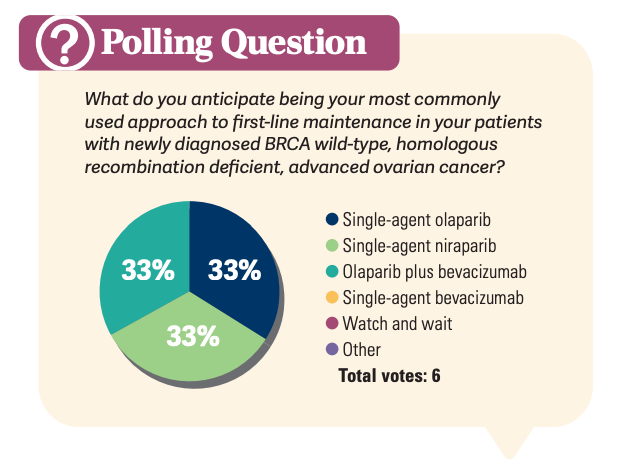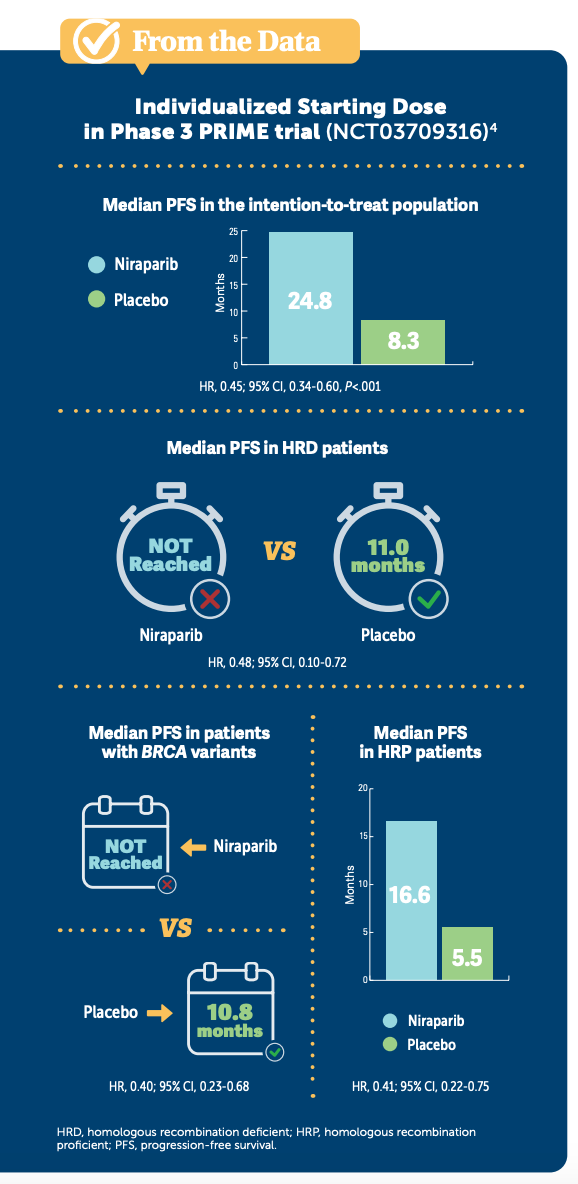McHale Analyzes the Benefits and Challenges of PARP Inhibition for Certain Patients With Advanced Ovarian Cancer
At a live virtual event, Michael McHale, MD, led a roundtable discussion on the use of PARP inhibition therapy for patients with advanced ovarian cancer.
Michael McHale, MD

Event Region: California

Event Summary: At a live virtual event, Michael McHale, MD, led a roundtable discussion on the use of PARP inhibition therapy for patients with advanced ovarian cancer. These therapies also have proven to be effective for several subgroups of patients with ovarian cancer, but challenges with toxicities remain. McHale goes through the advantages of this drug class and how to handle them effectively to make sure any patient with advanced ovarian cancer can receive tailored treatment.
Discussion Question: How do you counsel your patients about PARP inhibitor use in the primary maintenance setting?
PHAM: I quote the progression-free survival [PFS] data for patients when I’m counseling them [about their] therapy. It gives them a heads-up on what your expectations are [for therapy]. In terms of adverse events [AEs], [I watch out for and explain to them] anemia and thrombocytopenia, especially as thrombocytopenia is more of an issue with niraparib [Zejula].1 I’ve had some patients where I’ve had to dose reduce a lot, [and some] patients who discontinued treatment because of the cytopenias.
MCHALE: What if your patients had a problem with nausea during their primary therapy, does that modify what agent you use? Or what time of day [you tell them to take the dose]?
PHAM: [I would go with] PM dosing, and then we’ll usually premedicate if they’ve had prior issues.
CHAND: I usually recommend maintenance therapy for most of my patients with stage III or IV ovarian cancer, but I have not recommended maintenance therapy for any of my [patients with] stage II ovarian cancer. So I don’t even use bevacizumab [Avastin] for patients with stage II disease, whereas other people do. I’ve talked to my patients, and I let them know [that with] advanced ovarian cancer there’s an 80% chance that...these patients end up relapsing.2 Maintenance therapy does provide [the patient] with a chemotherapy-free interval, depending on how they respond and what sort of AEs they run into. For the most part, with niraparib, if you follow the weight based dosing and use olanzapine as a premedication at bedtime, it tends to [result in fewer] nausea AEs, compared with when I was using it initially and trying to catch up on [dealing with] their nausea later.... Thrombocytopenia has been an issue for some of my patients requiring further dose reductions, but not as often. But with olaparib the anemia tends to be when you start the medication, [and] after the patient crosses the 3-month interval that anemia...tends to disappear. Most patients after that usually tolerate the medication very well.
MCHALE: Have any of you encountered patients who have been on olaparib for 2 years, but then when you share with them the data...for this 2-year maintenance program they say, “Why would I stop olaparib? It’s working for me.” How do you then counsel patients regarding your rationale or recommendation for discontinuation of therapy, or do you allow them to continue?
LASHKARI: I generally follow the letter of the trials because I think the main reason is not knowing whether long-term [use] may be associated with a higher risk of secondary malignancy. Clearly, myeloid changes from myeloid disorders...are associated with their use.3 So it’s kind of like using a similar strategy with endocrine therapy [for patients with] breast cancer where [you can tell them how long this] was studied for and what would be recommended [at this point].

Discussion Questions:
• Are you familiar with the individualized niraparib starting dose based on baseline body weight and platelet count?
• How does this impact your treatment decisions?
MCHALE: There was a shift from fixed dosing [of niraparib] to individualized dosing, and what we saw was that there was a dramatic decrease in rates of grade 3 toxicities, specifically thrombocytopenia, anemia, and neutropenia.4 There was an exploratory analysis looking at the effect of this individualized dosing in the homologous recombination deficient [HRD] patient population, and what we saw was that the HR was well maintained at 0.39 [95% CI, 0.22-0.72].4 So if we look at the subgroups [of patients], specifically, the HRD subgroup, the median PFS was not reached vs the placebo, which was 11 months [From the Data4 ]. We also looked at [patients with] germline mutated disease, and at the time of this initial assessment the median PFS had not been reached [for those on niraparib], but the placebo group was at 10.8 months. It appears...that modifying the dose based on these individual risk factors for AEs did not have a significant effect on the observed HRs that were in favor of niraparib compared with placebo in this cohort of patients.4,5
DISCUSSION QUESTIONS
• What AE do you observe most frequently when using a PARP inhibitor in the primary maintenance setting?
• Which are the most challenging to manage?
• Have you noticed any toxicities you did not anticipate/were not reported in the literature?
• Do you notice any difference(s) in tolerability in the primary maintenance setting vs the relapsed/refractory setting?
MCHALE: It’s clear that PARP inhibition has changed the landscape, regarding the management of patients with advanced ovarian cancer, but, of course, there are challenges with PARP inhibition as maintenance therapy. The question I have for the group is...what AEs do you observe in your practice, and which do you find the most challenging in terms of maintaining patients on PARP maintenance therapy? Do you notice any difference in the tolerability [of PARP inhibitor therapy] in the primary maintenance setting vs what we typically see in the relapsed or refractory setting, [such as] with single-agent chemotherapy or single-agent therapy with bevacizumab?

LASHKARI: I typically notice cytopenias and gastrointestinal toxicities as being the most common AEs associated with PARP inhibitors in the maintenance setting. The difference between using PARP inhibitors in the primary maintenance setting vs in the relapse setting is that typically in the primary maintenance setting these patients have a better [ECOG] performance status and their disease tends to be better controlled. They may be either in a complete remission or a good partial remission, but the toxicities tend to be more drug related, whereas when you’re dealing with use of PARP inhibitors in the maintenance setting following a relapse/refractory time point, these patients may be dealing with concomitant disease-related AEs. In my practice, cytopenias tend to be a little bit more challenging, although gastrointestinal toxicities can persist, but generally they get better with time. With the cytopenias, once you’re able to do an appropriate dose modification, then it becomes manageable.
MCHALE: Do you see more of the gastrointestinal toxicities with any particular PARP inhibitor that you use in your practice? Or do you typically lean toward one PARP inhibitor vs another?
LASHKARI: For patients...who have pleural effusions at the time of diagnosis, typically, I will start them on up front bevacizumab [therapy]. At that point, I will either add in olaparib as maintenance therapy or continue the bevacizumab depending on their HRD and BRCA [mutation] status.
MCHALE: That’s typically what I do in my practice. I don’t frequently use bevacizumab as part of my primary therapy unless they have high-risk disease, stage IV disease, or residual disease. Then I’ll frequently add bevacizumab as part of their primary therapy, but depending on their homologous recombination status, I will then add olaparib.
LASHKARI: Increasingly, we’re using neoadjuvant treatment prior to surgery, at least in my practice, and that’s been my relationship with the gynecologic oncologists that I work with, as they are increasingly doing neoadjuvant therapy. And when I see [a patient with] higher-risk disease based on...[things] like, if they present with pleural effusions at stage IV, then is that when you don’t use bevacizumab? Or let’s say a patient presents with stage III disease, and they have a malignant [tumor] present, but it’s not stage IV, would you typically add in a platinum-based doublet?
MCHALE: There is not a lot of data [supporting] neoadjuvant bevacizumab with primary platinum-based therapy; however, we still do it because of the [limited supporting] data out there. We’ve made that leap of faith, and then if it works after a primary site reduction, then why shouldn’t we use it in the neoadjuvant setting? And I will use it there, because I do think it helps symptomatically…so that these patients can eat and hopefully improve their nutritional status before I take them to a big set of dose reductions. So I will use it and then continue it thereafter, and if they’re [homologous recombination] proficient [HRP], then I’ll just continue bevacizumab, but if they’re HRD, then I’ll add the olaparib. Any other comments from anybody?
CHANDURI: I think olaparib 300 mg [given twice a day] to a patient with refractory/relapsed disease is very difficult. I haven’t been able to use the dose because of cytopenias [that force us to] reduce the dose. Even [with niraparib] at 200 mg, or the dose based on the weight and platelet count...they still have a lot of toxicities, like fatigue, and at some point we may have to reduce that dose as well. That’s my experience [when treating these patients].
MCHALE: Our indications for PARP inhibitors are dwindling, as we all know. From my perspective, I think our most important time to expose patients to this class of drug is at frontline therapy, and clearly there is still an indication for second-line platinum-sensitive patients who [harbor a] BRCA mutation, but these indications are slowly shrinking. So I think we’re going to be seeing this in managing these toxicities in the frontline setting more commonly, and it’s getting limited for later lines of therapy. SHIN: I am still unclear as to the benefit of maintenance PARP inhibition for patients with [homologous recombination] wildtype disease. I have offered a PARP inhibitor [to a patient like this] and she decided not to take it. What’s your take on the role or benefit of PARP in [patients with wild-type mutations]?
MCHALE: I have the same conversation [with patients like that], and I certainly understand your sentiment, because when you look at the data, we could consider it for HRP patients, which comes from the [phase 3] PRIMA trial [NCT02655016].6 There’s about a 3-month difference in PFS there, and I struggle with that. Although it was statistically significant in favor of giving niraparib to that patient population [HR, 0.43; 95% CI, 0.31-0.59, P<.001],6 I struggle with using that as part of my maintenance strategy for those patients knowing the potential toxicities that are associated with it. So I have the conversation [with the patient and] I share with them the data in a simplistic form, but I also share with them the potential toxicities they may experience while taking niraparib. However, if they do choose to pursue it, I am quick to dose reduce and quick to discontinue therapy. And even though when you look at the PRIMA data, the [discontinuation] rates were in the single-digit percentiles for the entire population, I have to say that based on the PFS data, I tend to recommend discontinuation maybe a bit sooner than I would in someone who is HRD who clearly is going to benefit or even someone [with a] BRCA [mutation] who is clearly going to benefit [in comparison to the] toxicity associated with that drug.6 I don’t know if anyone else has any thoughts, but it’s a challenging population in terms of what to do with that group of [patients] who are [homologous combination] proficient.
SHIN: In your experience, do more patients choose to take it, or not?
MCHALE: It’s about 50/50. I just had this conversation [with a patient], and she opted to decline [niraparib] even though we went through the data...in great detail and she was well versed in all the trials, such as the PRIMA publications and the subsequent publications. But she ultimately...decided not to pursue [PARP inhibition]. The challenge is, if she recurs, which we all know she probably will, the [indication for] PARP inhibition at that point… no longer exists. Again, it’s limited to the [patients with] BRCA [mutations in the] second-line setting.
REFERENCES
1. Berek JS, Matulonis UA, Peen U, et al. Safety and dose modification for patients receiving niraparib. Ann Oncol. 2018;29(8):1784-1792. doi:10.1093/annonc/mdy181
2. Luvero D, Plotti F, Aloisia A, et al. Ovarian cancer relapse: from the latest scientific evidence to the best practice. Crit Rev Oncol Hematol. 2019;140:28-38. doi:10.1016/j.critrevonc.2019.05.014
3. Morice PM, Leary A, Dolladille C, et al. Myelodysplastic syndrome and acute myeloid leukaemia in patients treated with PARP inhibitors: a safety metaanalysis of randomised controlled trials and a retrospective study of the WHO pharmacovigilance database. Lancet Haematol. 2021;8(2):e122-e134. doi:10.1016/S2352-3026(20)30360-4
4. Mirza MR, González-Martín A, Graybill WS, et al. Prospective evaluation of the tolerability and efficacy of niraparib dosing based on baseline body weight and platelet count: Results from the PRIMA/ENGOT-OV26/GOG-3012 trial. Cancer. 2023;129(12):1846-1855. doi:10.1002/cncr.34706
5. Li N, Zhu J, Yin R, et al. Treatment with niraparib maintenance therapy in patients with newly diagnosed advanced ovarian cancer. JAMA Oncol. 2023;9(9):1230-1237. doi:10.1001/jamaoncol.2023.2283
6. González-Martín A, Pothuri B, Vergote I, et al. Niraparib in patients with newly diagnosed advanced ovarian cancer. N Engl J Med. 2019;381(25):2391-2402. doi:10.1056/NEJMoa1910962

Advances in Subsequent Therapies Shake Up Sequencing of ccRCC Treatment
April 25th 2024With the approval of belzutifan and other newer data for treating patients with recurrent renal cell carcinoma, the state of subsequent therapies is advancing beyond the reuse of frontline options with impacts on duration of response and quality of life.
Read More
Novel Approaches Focus on Limiting Toxicity in Older Patients With ALL
April 22nd 2024The major challenges for clinicians treating older patients with acute lymphoblastic leukemia surround the emergence of resistance to existing therapies and the toxicities associated with current chemotherapies.
Read More